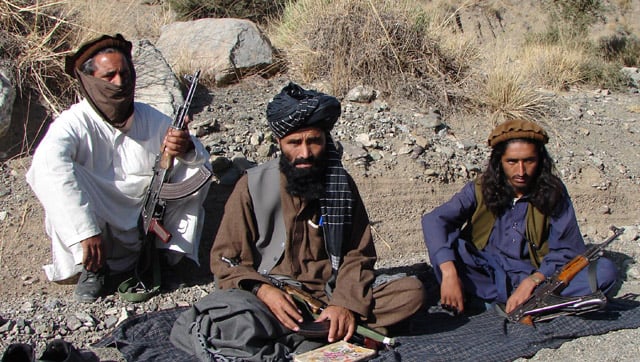
Interestingly, Pakistan’s militant and right-wing media in general focuses on the West as an enemy. According to Faizullah Jan, who teaches at Peshawar University and has come out with a fantastic study of militant discourse in the country, the West is perceived as the “far enemy”, which is out there to destroy Muslims, especially of Pakistan. In his recently published book, The Muslim Extremist Discourse, he has looked at the extremist’s conceptualisation of the self and the other in the war on terror. Jan has systematically examined numerous publications of the Jamaat-e-Islami (JI), the Jaish-e-Mohammad (JeM) and the Jamaatud Dawaa (JuD) to understand their worldview as reflected in the debate over three events: a) the operation to kill Osama bin Laden in Abbottabad; b) the ban on YouTube in Pakistan due to the presence of an anti-Islam film on the website; and c) the shooting of Malala Yousufzai. The author has correctly pointed out the significance of narratives, which are critical tools to create a social reality that is then marketed amongst the clientele of a group or party.
It is important to examine the extremist discourse because not only is it a good measure to gauge the perspective of militants, it also fosters the realisation, as Jan points out, that this narrative will exist beyond the end of the war on terror. In fact, this literature is central to radicalism, which feeds violent extremism in the country and amongst Muslim communities. But this literature is not exclusive as it is not present in total isolation from the mainstream media discourse (particularly in Urdu), which has begun to echo an almost similar perspective on numerous issues, certainly on the three events cited above.
One of the key points of extremist literature is focused on presenting the West as the negative, the enemy or the ‘other’ that must be fought. This is a common theme that runs through the description and debate over the three events, which Jan categorises as ‘three moments’. Hence, we see that despite some of the jihadi media’s initial reaction of even sympathising with Malala Yousufzai after the attack on her or reminding people that Islam forbids attacks against women and children, the tone changes quickly and she begins to be presented as an enemy agent or as an excuse used by Americans to attack Muslim Pakistan. The shift in how an event is portrayed is also obvious from how OBL’s killing is described. While the initial reaction is to deny that such a thing ever happened, this is followed by a tirade against the US. Later, OBL’s killing is described as the epitome of martyrdom and his description then takes the form of myth-building in which he is presented as Arab royalty, who like Buddha, abandoned the comforts of his home and hearth to lay down his life in order to protect Islam. Furthermore, OBL is also likened to a Sufi and majnun (a great lover). Referring to similarities with historical characters, is done as part of necessary myth-building that gives the believer a feeling of reliving the early days of Islam. One wonders if that is because Muslims of the subcontinent were, historically, converts from Buddhism, Hinduism or Sikhism and that is why the image of historical characters is sometimes resurrected like deities. Every other militant appears to take the name of a companion of the Holy Prophet (peace be upon him) or the early commanders of Islam to give him a sense of being part of history.
A parallel theme that we see running through publications like the Urdu daily Jasarat, the JeM’s Al-Qalam and Zarb-e-Momin, the JI’s daily Islam, the JuD’s Jarrar, or Al-Rashid Trust’s Al-Amin is the presentation of rulers and the leadership as the ‘near enemy’. According to Jan’s analysis, the theme of financial, political and moral corruption of rulers is a pervasive one. Not that militants have to struggle a lot to convince their readers of this, but there is a very systematic description of rulers as people ‘who have sold out their conscience for dollars’, and help the US ‘violate our sovereignty by carrying out drone attacks’. Although not mentioned by Jan, a large part of the same literature denounces democracy as an unacceptable and corrupt system. The hatred for democracy, in fact, is a common thread which runs through the literature produced by al Qaeda, JuD and JeM. The religious wings and sectarian groups, which these violent extremists are ideologically linked with, have a similar narrative. But more importantly, liberal intellectuals in Muslim countries are also equated with the ‘near enemy’, and hence a threat to Muslim identity.
The natural progression of the above argument is the enforcing of a caliphate that would represent the rule of believers. The denunciation of the existing political system is critical in establishing logic for a utopia, based on an Islamic system that espouses the idea of justice for all. Therefore, the identity of the ‘favoured’ Muslim and the militant is crafted carefully. This was most obvious from the way in which militant literature hid the identity of those who attacked Malala Yousufzai. This was to ensure that any sympathy for the young girl may not turn people against the Taliban who had attacked her.
Interestingly, despite the common threads found in all extremist discourse, the Pakistani state tends to distinguish between the good and the bad extremist. Such an attitude ignores the power of discourse and how it is changing the way people think about the ‘near’ and ‘far’ enemies and friends. The need for a counter-narrative is urgent.
Published in The Express Tribune, January 14th, 2016.
Like Opinion & Editorial on Facebook, follow @ETOpEd on Twitter to receive all updates on all our daily pieces.











COMMENTS (6)
Comments are moderated and generally will be posted if they are on-topic and not abusive.
For more information, please see our Comments FAQ